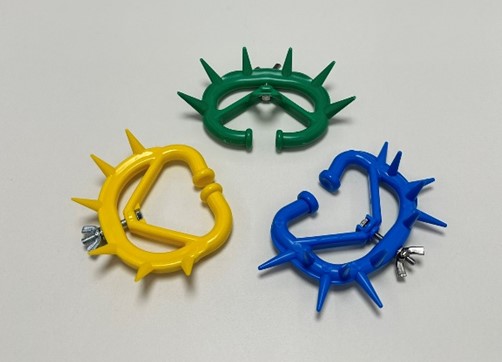Anti-Milk Rings: Effective Practices and Rules of Use

Photo is illustrative in nature. From open sources.
In modern agriculture, anti-milking rings have become an important tool for ensuring dairy herd health and increasing productivity. In this article, we'll look at how to properly use anti-milking rings for maximum effectiveness.
1. Selecting Suitable Rings
The first step in using anti-milking rings is to select the appropriate model for your herd. Different animals and operating conditions may require different types of rings, so it is important to take into account all the features of your farm.
2. Correct Installation
Correct installation of rings is the key to their effectiveness. Make sure they fit snugly on the udder and do not cause discomfort to the animals. Proper fit will also prevent animals from accidentally removing the rings.
3. Monitor Udder Health
When using anti-milking rings, regularly check the condition of the animals' udders. Pay attention to possible signs of inflammation, redness or swelling in order to promptly identify and prevent udder diseases.
4. Use modern monitoring technologies
Many modern anti-milking rings are equipped with monitoring technology. Use these features to monitor udder health and milking efficiency. This data can help you make informed decisions to improve your herd care.
5. Train Animals
It may take time for animals to adapt to new conditions, including the use of anti-milking rings. Provide positiveexperience for the animals, giving them enough time to get used to the new equipment.
6. Regular Cleaning and Maintenance
To ensure long life of the anti-leakage rings, perform regular cleaning and maintenance procedures. Ensure that ring devices are in good condition and replace them as necessary.
7. Maintain Hygiene Standards
Hygiene standards play an important role in preventing infections and inflammation of the udder. Ensure equipment is clean, use antiseptics, and maintain general hygiene standards.
8. Use in Combination with Other Methods
The use of anti-milking rings may work best when combined with other methods of udder care and flock health monitoring.
9. Consultations with Professionals
If you have any questions or concerns, please consult your veterinarian or livestock specialist. They can provide valuableadvice andassistance in optimizing the process of using anti-milking rings.
10. Monitor the Herd's Reaction
Observe the behavior of the herd and the reactions of the animals to the use of rings. If there areproblems or changes in behavior, contact your veterinarian for further evaluation.
In general, proper use of anti-milking rings requires careful implementation and adherence to manufacturers' recommendations. Using modern technology and an emphasis on caring forherd health , these tools can be an effective means of optimizing milk production and ensuring the well-being of your livestock.
Read together with it:
- A friend's advice helped save the marriageI am 37 years old, my husband is 32. When I met him, I already haddaughter from her first marriage.I didn’t live long with my first husband. Tired of constant betrayal and lies, I got divorced and decided that I would raise my daughter myself. But over time, everything was forgotten, and I met Oleg....
- Reward for ForgivenessBy 2000, my parents left me without a roof over my head, saying: “It’s okay, you’ll earn money yourself.” Where can a doctor in our country earn an apartment?I wandered around strange corners for 10 years, rented rooms with hostesses, and earned money. I was able to save a little and was looking for...
- My father kicked me out of the house, and now I have to take him in with meDad raised us as best he could alone. Me, sister and brother. My grandmother also helped as much as possible with her pension. We lived in my mother's apartment.When I was 17 years old, my grandmother died and upon completion she left me an apartment, andfather thought thatthe apartment will be his....
- 122nd passengerThis happened in the first days of 1994. My family and I lived in Irkutsk at that time. We celebrated the New Year cheerfully , and on the third of January I had a business trip to St. Petersburg with a stop in Moscow. At the end of December I bought a plane ticket.The main thing is that there shoul...
- My wife hid the truth from me about buying a new carOur family has a car. Not luxurious, but a decent foreign car. I always take my wife to work and pick her up from there. She has a license and takes the car whenever she needs it. Butmy wife decided that she needed her own car.I tried to explain to her that this was not necessary, but she stood her ...
- After having a baby, I found myself in a dead end.I am 27 years old, my husband is 35, we got married 2 years ago. Now andthe child is 1.4 years old. We live with my parents, I lived with my mother-in-law for 2 months, I moved out of there, it’s impossible to live with her, turn off the water, the lights are on in vain. It got to the point that she...
- Doctor-patient syndromeI have since childhoodproblems with blood vessels and reached the point where surgical intervention was needed. For a long time I didn’t dare to do this, but in an instant I plucked up the courage, and they signed me up for a planned operation, but which doctor was a surprise. The day came when it w...
- Holiday experiment with husband and girlfriendCame outI got married nine years ago. Before that, we had been dating for four years. The relationship has always been romantic. Butmy husband found a good permanent job and became more married to her than to me. This situation didn’t make me very happy; sometimes he doesn’t even spend the night at ...
- My childhood complexes prevent me from building relationships with menMy childhood and adolescence are a story about an ugly duckling. Fat and scary. She weighed a lot (really a lot, more than a hundred kilograms,problems with hormones), problematic skin (again, hormonal imbalance), a sea of complexes. But in college times everything changed. I took care of myself, ...

